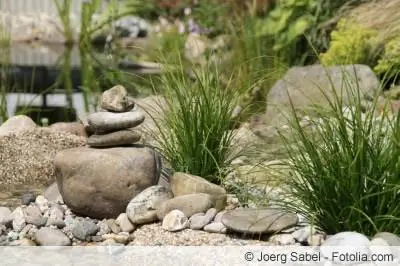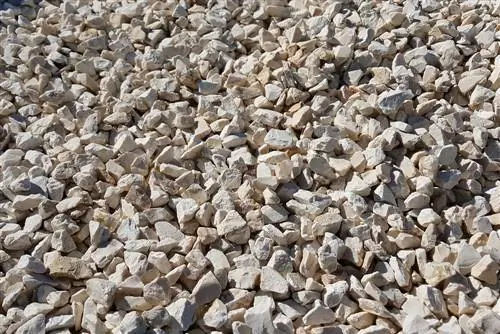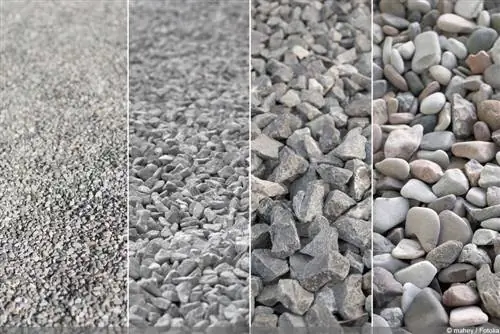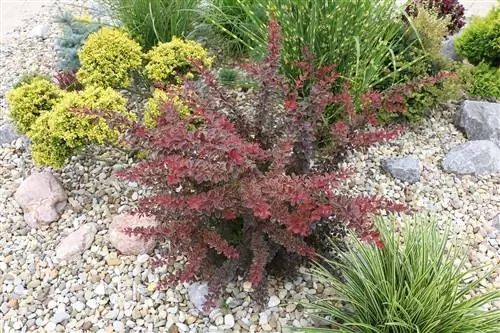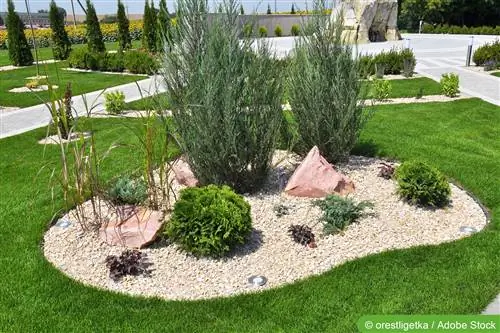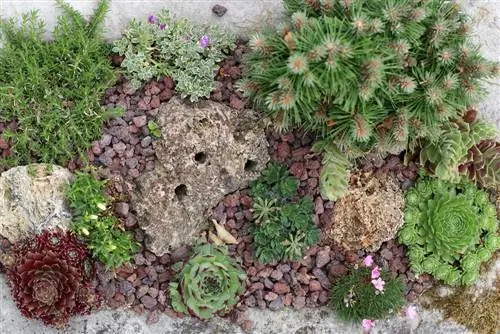- Author admin [email protected].
- Public 2023-12-17 03:39.
- Last modified 2025-01-24 12:45.
With a gravel bed, the magic of Tuscany and the grace of Asia enter the garden. At the same time, the design variant solves many location problems in terms of overall planning. Good to know that this unique combination of stones and plants creates space for exotic plants that thrive where classic perennials have long since given up. The reduction to clear shapes creates a visual aura in the garden that is fascinating without requiring an extra dose of care. These DIY instructions show in practice how to skillfully create and design a gravel bed.
Selection of location and soil preparation
You can still take your time deciding on the specific style, because the site conditions and the processing of the soil take place regardless of whether you are creating a Mediterranean, Japanese, formal or alpine gravel bed. The following overview shows what is important:
- Full sun to sunny location
- Dry, sandy-gravelly soil with some loamy topsoil
- Low in nutrients, with low humus content
- Well drained, without risk of waterlogging
Where the soil condition does not come close to ideal conditions, you can take targeted measures to influence it. To do this, dig the intended bed area to a depth of 25-30 centimeters and meticulously remove all roots from the sole. Then mix half of the excavated material with gravel to fill the mixture back in as a substructure. If a vibrating plate is available, the substrate is solidified. Alternatively, smooth the bed surface with a lawn roller that is as heavy as possible. Spread a sturdy weed fleece over it, overlapping the edges by at least 10 centimeters.
Tip:
The mounds typical of an alpine gravel bed are most easily created with the soil from the substructure so that they can also be covered with the weed fleece. In this way, later planting of the small elevations is possible without any problems.
Beautiful ornamental gravel varieties
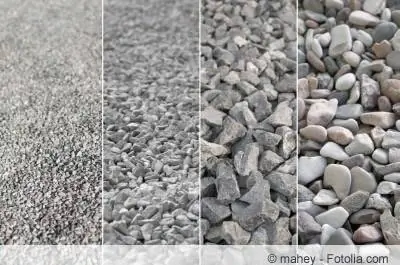
With the prepared bed in mind, the decision regarding the stylistic direction is usually a little easier. The choice of types of ornamental gravel is defined by the design characteristics. While reddish-brown to terracotta or burgundy nuances mixed with white tones are welcome in the Mediterranean aura, white, gray and black tones determine the appearance in the Japanese and formally oriented gravel bed. The Alpine style, on the other hand, grants the creative hobby gardener more individual freedom of choice, as long as the vision of seemingly natural nature emerges. The following selection of recommended types of ornamental gravel may serve as inspiration:
- Carrara marble, pure white
- Bas alt, extra black
- Bordeaux pebbles, beige
- Natural granite light gray speckled
- Quartz, black and white veins
- Rose quartz, delicate pink
- Glacier gravel, colorfully mixed
Rounded ornamental gravel has a harmonious appearance, but also poses a high risk of slipping when it is wet. This problem is solved by curved paths on larger bed areas, covered with sharp-edged decorative chippings. This design variant also offers the possibility of creating a color contrast between paths and the area to be planted. In addition, the different grain sizes contribute to a varied look. While a grain size of 16/25 to 25/40 is advantageous for decorative gravel, a grain size of 8/16 to 16/32 is ideal for decorative gravel.
Design a Mediterranean gravel bed
The plants of the Mediterranean region thrive extremely luxuriantly in the sandy-gravel soil of the gravel bed. The following collection of flowering perennials, delicate grasses and decorative trees is ideal for the dominant bed in the garden or the sunny front garden bed.
- Lavender (Lavandula angustifolia)
- Butterfly bush (Buddleia davidii)
- Feather carnation (Dianthus plumarius)
- Pearl basket (Anaphalis triplinervis)
- Small Iris (Iris Barbata-Nana)
- Blue cushion (Aubrieta x cultorum)
- Blue oats (Helictotrichon sempervirens)
- Palm lily (Yucca filamentosa)
- Gypsophila (Gypsophila repens)
So that the flower spectacle begins early in the year, plant bulb flowers in suitable places, such as daffodils, tulips, crocuses and snowdrops. Although these are not typical Mediterranean plants, this design is seen as artistic freedom on the part of the gardener.
Create a Japanese gravel bed
A Far Eastern dream comes true with the following plant community, which is only planted sporadically in the gravel bed. In a stylish design, the emptiness of the room dominates, lightened up by solitary trees such as bonsai, perennials and grasses.
- Bamboo (Nandina domestica)
- Japanese maple (Acer palmatum)
- Japanese columnar cherry (Prunus serrulata Amanogawa)
- White Japanese anemone (Anemone japonica Honorine Jobert)
- Magnolia as a standard tree (Magnolia liliiflora)
- Bearskin grass (Festuca gautieri)
- Pendulum sedge (Carex pendula)
- Funkie (Hosta)
- Tibet summer primrose (Primula florindae)
- Phlox divaricata
Add other design elements, such as stone pagodas, lanterns and statues. In the large Japanese-style gravel bed, a stone bench invites you to linger. Avoid geometric shapes when creating, because curved lines set the tone in the Japanese garden. Where it is not possible to integrate the element of water in nature, decorative gravel and chippings simulate the course of a stream.
Create an Alpine character
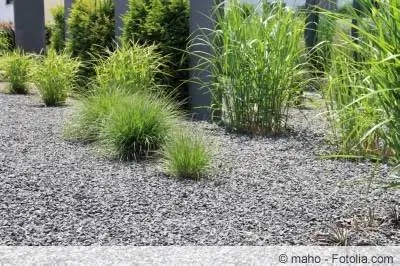
If a gravel bed has a slight slope or small hills, you can imitate an alpine landscape with stones and suitable plants. The following species and varieties make an excellent contribution to this design variant:
- Mountain pine (Pinus mugo)
- Snow heather (Erica carnea)
- Rock plate (Ramonda)
- Gentian (Gentiana)
- Edelweiss (Leontopodium)
- Alpine bellflower (Campanula alpina)
Anyone who has ever been out in the mountains is aware that stones play a key role in the design. The Alpinum is, of course, far from having an orderly structure like the formal or Japanese gravel bed. As is usual in the wild, preference should be given to a cheerful mix of shapes and colors, ideally supplemented with mighty boulders from the region.
Dry shade problem solution
Are you struggling with a spot in your garden under tall trees or in a shady corner where nothing wants to grow? Then the gravel bed is a good solution. In this case, only plants that do not place a high value on permanent sunshine are suitable, such as the following selection:
- Spurge (Euphorbia amygdaloides)
- Waldsteinia (Waldsteinia ternata)
- Comfrey (Symphytum azureum)
- Foxglove (Digitalis ferruginea)
- Sedge (Carex)
- Red Veil Fern (Dryopteris erythrosora)
- Goat's beard (Aruncus dioicus)
As long as there is no Egyptian darkness at the location, you can transform previously barren regions of the garden into a decorative eye-catcher with a gravel bed. Since a more nutrient-rich substrate is required in this case, adding bulkheads to the topsoil can be dispensed with.
Plants
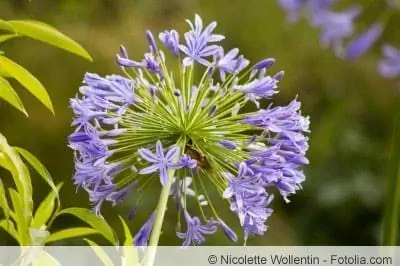
Once the preparatory work has been completed and the selected plants are ready, the gardening work begins. The young plants that are still potted are placed with their root ball in water until no more air bubbles appear. Then place the plants in their place on the weed fleece in order to check the arrangement again. In these steps you create the gravel bed:
- Cut the weed fleece in a cross shape at the location of each plant using a sharp knife
- Using a hand shovel, create a pit with 1.5 times the volume of the root ball
- Put the potted plant in there and water it
- Close the fleece as completely as possible up to the root neck
- To finish well, distribute the gravel in the bed. It is recommended to first create the paths with the chippings and then spread the gravel to a height of 5 to 8 centimeters.
Tip:
Distributing decorative gravel and grit is easier if you protect each plant with its upside-down plastic pot or bucket.
Tips for care
Once the gravel bed has been created and designed, you will spend a lot more time relaxing in it than caring for it. One of the outstanding advantages of this bed variant is its remarkable undemandingness. The following care tips show how it works:
- Water the plants regularly while they are growing
- Then only water when it is dry in summer
- Do not leave autumn leaves lying around for a long time, but remove them as soon as possible
- Starting fertilization in the spring in the form of compost or organic liquid fertilizer is sufficient
As a rule, you can meet the requirements by pruning shrubs and perennials in early spring. Early flowering shrubs receive a shape and maintenance pruning immediately after flowering. However, faded and wilted herbaceous plants should be removed in autumn so that the decorative gravel does not become unnecessarily dirty.
Conclusion
A gravel bed brings variety to the garden appearance, solves location problems and is extremely easy to care for. Once established, the need for attention is limited to watering in dry conditions, a little fertilizer every now and then and any pruning. Reason enough to use these DIY instructions to create and design a stylish gravel bed in just a few steps.

